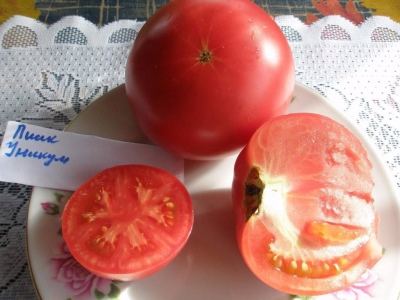
- Authors: Monsanto Holland B. V.
- Year of approval: 2008
- Name synonyms: Pink Unicum
- Category: hybrid
- Growth type: indeterminate
- Appointment: fresh consumption, for pickling and preserving
- Ripening period: mid-early
- Ripening time, days: 120
- Growing conditions: for open ground, for film greenhouses, for greenhouses
- Marketability: high
Such an unusual name immediately betrays the foreign origin of the culture. And yet it performs very well in the conditions of domestic sites. You just need to carefully study the features of the plant, and make a thoughtful decision.
Breeding history
The developers of such a tomato are breeders of the well-known company Monsanto Holland B. V. In Russia, this variety was allowed for use in 2008. It must be emphasized that from a botanical point of view, this is not a simple variety, but a hybrid. The plant has a synonym - Pink Unikum.
Description of the variety
You can grow Pink Unicum in glass and film greenhouses. But this culture is also suitable for planting in a regular garden. The plant will develop according to an indeterminate scenario. Since it is a hybrid, it is not possible to use your own seeds for breeding. Powerful tomato stems grow up to 150 cm, and its foliage is not too large.
The main qualities of the fruit
Pink Unicum berries that have just emerged from the ovaries are colored in a light green tone. The ripe crop will be pink and will not be covered with any spots normally, even in the area of the stalk. Other indicators:
large size;
usual weight 250 g;
development from simple inflorescences;
quite impressive keeping quality;
the formation of 4-6 fruits in each hand;
rounded shape with poorly defined ribs.
Taste characteristics
In general, the taste of Pink Unicum tomatoes is pleasant. They note that these fruits are sweetish. The pulp in the berries is fleshy and juicy. It attracts attention with its excellent density. The relatively thin rind has little effect in terms of flavor.
Ripening and fruiting
By the timing of reaching maturity, Pink Unicum is classified as a mid-early tomato. Under normal conditions, it takes 120 days for its development. However, sometimes the crop appears a little earlier or later (taking into account agricultural technology and actual weather). You can harvest from July to September inclusive.
Yield
The plant is considered a high-yielding tomato. Potentially, it is possible to collect more than 16 kg of berries per 1 sq. m. However, much depends on the weather and the diligence of the farmers.
The timing of planting seedlings and planting in the ground
It is necessary to sow seeds in the substrate in containers approximately during March. If the seedlings themselves develop well, it will be possible to transfer them into open ground in May or July. It is most likely to focus on the actual state of the plants themselves and on the readiness of the soil, as well as on the weather.

Growing tomato seedlings is an extremely important process, because it largely depends on whether the gardener can harvest at all. All aspects must be taken into account, from seedbed preparation to planting in the ground.
Landing scheme
Pink Unicum feels the best when seated according to the 700x300 mm system.Farmers have not yet had any reason to complain about such a recommendation of a supplier of planting material.

Growing and care
It is necessary to form bushes of this variety strictly in 1 stem. It is this approach that allows you to potentially achieve the highest effect. When transplanting into open ground, it is very important to use not only humus, but also wood ash. The temperature should not be allowed to fall below +15 degrees. That is why the use of greenhouses is highly recommended in all cold regions.
Normal humidity is 70 to 80%. When 5-6 brushes are formed, all lateral shoots are removed. To better develop the ovaries, it is necessary to pinch the growth points. During the growing season, the bushes should be fed 3 or 4 times with complex mineral fertilizer. It is necessary to water the bushes in moderation, focusing on the drying out of the earth.




A plant needs different micronutrients at each stage of growth. All fertilizers can be divided into two groups: mineral and organic. Folk remedies are often used: iodine, yeast, bird droppings, eggshells.
It is important to observe the rate and period of feeding. This also applies to folk remedies and organic fertilizers.
Disease and pest resistance
Cracking of fruits is not very typical for this variety. It is officially stated that he steadfastly endures defeat by cladosporium and verticillosis. Tobacco mosaic and fusarium wilting shouldn't be scary for him either. Sophisticated treatments are only needed in a critical setting. Pests specific to this variety have not been described.


Resistant to adverse weather conditions
Pink Unique is stress-resistant. This means, by the way, that almost any sharp fluctuations in meteorological conditions are not too scary for him. But all the same, it is advisable to protect plants from excessive cold and heat.
Review overview
According to gardeners, Pink Unicum can indeed form powerful bushes. The problem with this is the susceptibility to apical rot. The taste of the harvest pleases even the most discerning consumers. However, some farmers find themselves disappointed. It can be assumed that a lot depends on personal diligence and compliance with agricultural standards.

























































































